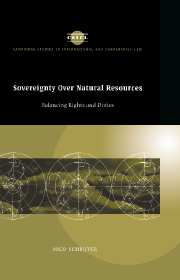Book contents
- Frontmatter
- Contents
- List of boxes, figures and tables
- Preface
- Acknowledgments
- List of abbreviations
- List of main symbols used in UN documents
- Glossary
- Table of cases
- 1 Introduction
- PART I The birth and development of the principle: the UN General Assembly as midwife
- Introductory remarks to Part I
- 2 The formative years (1945–1962)
- 3 Promoting economic development by the exercise of permanent sovereignty: the period after 1962
- 4 Permanent sovereignty, environmental protection and sustainable development
- 5 Permanent sovereignty over natural resources in territories under occupation or foreign administration
- PART II Natural-resource law in practice: from creeping national jurisdiction towards international co-operation
- PART III Balancing rights and duties in an increasingly interdependent world
- Appendices
- Bibliography
- Index
- Books in the series
Introductory remarks to Part I
Published online by Cambridge University Press: 23 October 2009
- Frontmatter
- Contents
- List of boxes, figures and tables
- Preface
- Acknowledgments
- List of abbreviations
- List of main symbols used in UN documents
- Glossary
- Table of cases
- 1 Introduction
- PART I The birth and development of the principle: the UN General Assembly as midwife
- Introductory remarks to Part I
- 2 The formative years (1945–1962)
- 3 Promoting economic development by the exercise of permanent sovereignty: the period after 1962
- 4 Permanent sovereignty, environmental protection and sustainable development
- 5 Permanent sovereignty over natural resources in territories under occupation or foreign administration
- PART II Natural-resource law in practice: from creeping national jurisdiction towards international co-operation
- PART III Balancing rights and duties in an increasingly interdependent world
- Appendices
- Bibliography
- Index
- Books in the series
Summary
This Part maps the history of the principle of permanent sovereignty over natural resources from its birth in the United Nations and its evolution from a political claim to an accepted principle of international law. The hypothesis is that resolutions of the political organs of the United Nations, especially the General Assembly, have been instrumental in achieving this acceptance. This is not to say become the ‘modern source of international law’, as Bedjaoui suggested in reference to their flexibility, rapid formulation and democratic nature as opposed to the inability of custom to respond to contemporary challenges and to the limitations of treaties which are not always a manifestation of free will. However, on the other hand we do not subscribe to Schwarzenberger's view that the entire permanent sovereignty exercise ‘is no more than a convenient para-legal ideology of power economics’ and that the term ‘permanent sovereignty over natural re sources’ is ‘meaningless’.
The intention is to present a reading of primary sources in order to put the UN debate on permanent sovereignty in perspective and to show that the UN performed a number of key functions in the process of acceptance. The UN took stock of demands initially formulated in particular by Latin American States but shortly thereafter supported by socialist countries from Eastern Europe, thus embroiling the permanent sovereignty debate in Cold War rivalry, as well as demands by newly independent States of Asia and Africa, which caused permanent sovereignty to become an issue of North–South confrontation.
- Type
- Chapter
- Information
- Sovereignty over Natural ResourcesBalancing Rights and Duties, pp. 33 - 35Publisher: Cambridge University PressPrint publication year: 1997
- 2
- Cited by

